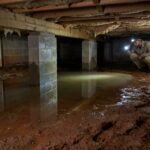Essential Guide to Foundation Repair: Ensuring Your Home’s Stability and Longevity
When it comes to maintaining a home, many homeowners focus on the visible aspects such as paint, roof, and landscaping. However, one of the most critical components often overlooked is the foundation. Your home’s stability and longevity hinge on a solid foundation. If you’ve noticed cracks in your walls or uneven floors, it might be time to dig deeper – not literally, of course! Welcome to the essential guide to foundation repair, where we’ll explore everything from signs of foundation issues to repair methods that will have your home standing strong.
### Understanding Your Foundation
Before diving into repairs, let’s take a moment to appreciate the hero that is your foundation. It’s the unsung champion that bears the weight of your entire home while battling moisture, soil displacement, and even the occasional supernatural force (just kidding, unless you live in a haunted house). Foundations can be made from various materials including concrete, masonry, and wood, each coming with its own set of benefits and potential pitfalls.
1. **Types of Foundations**:
– **Basement Foundations**: These are built below ground level and can provide additional living space but may be prone to moisture issues.
– **Crawl Space Foundations**: Typically used in areas with high water tables, these allow for air circulation but can also harbor pests if not maintained.
– **Slab Foundations**: A concrete slab poured directly on the ground; they’re efficient but can crack under pressure, much like we all do during tax season.
– **Pier and Beam Foundations**: These involve wood beams resting on piers above the ground, providing good ventilation but demanding regular inspections.
### Signs Your Foundation Needs Attention
Knowing the signs of a failing foundation can mean the difference between a simple repair and a full-blown disaster. Here are some red flags to watch for:
– **Cracks in Walls and Ceilings**: Small hairline cracks may be normal, but large, stair-step cracks or those wider than a quarter indicate serious issues.
– **Doors and Windows That Stick**: If your door suddenly requires the strength of Thor to close, your foundation may be shifting.
– **Uneven Floors**: Floor slopes might make you feel like you’re auditioning for a role in a sitcom about wacky home repairs.
– **Gaps Around Windows and Doors**: Noticeable gaps can indicate that your structure is settling or shifting.
– **Water Accumulation**: Pools of water near your foundation after heavy rains? Your foundation might need more than just a raincoat.
### The Importance of Timely Repairs
Ignoring foundation problems is akin to ignoring a ticking time bomb. While it might seem harmless at first, what starts as a small crack can evolve into major structural damage, leading to costly repairs and potentially compromising your home’s safety. Plus, who wants to live in a place that feels like it’s about to topple over like a Jenga tower?
Timely repairs not only preserve the value of your home but can also prevent health hazards like mold growth, which loves damp environments more than we love Friday pizza nights.
### DIY vs. Professional Help: What’s the Best Approach?
This is where homeowners often find themselves standing at a crossroads. On one side, you have the DIY approach, where you channel your inner handyman, armed with YouTube tutorials, a toolbox, and a questionable amount of confidence. On the other, you have professional services, which can be more expensive but typically offer peace of mind.
**DIY Repairs**:
– Small cracks can sometimes be filled with concrete patching compound. If your cracks look like they were made by a Picasso, consult a professional!
– Make sure drainage systems are clear and functioning. While you’re at it, check for gutters that might need cleaning. Remember, a well-drained foundation is a happy foundation.
**Professional Repairs**:
– If you face significant issues (we’re talking wall tilt or crumbling foundations), it’s best to call in the pros. They bring expertise, specialized equipment, and the assurance that your house won’t suddenly decide to be a funhouse.
### Common Foundation Repair Techniques
If you’ve decided to invite professionals to the rescue, here’s a rundown of some common repair techniques they might employ:
– **Mudjacking**: This method involves injecting a mixture of cement and other materials into the soil beneath your foundation to raise it back to its original position. It’s like giving your foundation a little lift – no gym membership required!
– **Piering and Underpinning**: This technique involves adding support beneath your foundation through the use of piers. Think of it as creating a sturdy ‘bed’ for your home to rest on.
– **Carbon Fiber Straps**: For homes with bowing walls, carbon fiber straps can be used to reinforce the walls. It’s the superhero cape your house didn’t know it needed!
– **Wall Anchors**: These are installed to prevent further movement in basement walls. They work by anchoring the walls to stable soil away from the foundation – a safety net of sorts.
### Preventative Measures for Your Foundation
Prevention is always better than cure, especially when it comes to foundational stability. Here are some tips to help keep your foundation healthy:
– **Maintain Drainage**: Ensure that rainwater flows away from your foundation. Install gutters, downspouts, and grading to direct water away. If rivers are starting to form, you might be doing it wrong.
– **Check for Tree Roots**: Trees are lovely until their roots start to invade your foundation. If you suspect this is happening, consult an expert about the best way to manage the situation without sacrificing your beloved oak tree.
– **Regular Inspections**: Just like visiting the doctor for check-ups, schedule regular foundation inspections to catch potential problems early. Trust us; your future self will thank you for being proactive.
– **Control Indoor Humidity**: Keep humidity levels in check to prevent moisture-related issues. A dehumidifier can be your best friend, especially in basements.
### When to Call for Help
While minor issues can sometimes be handled independently, knowing when to call in reinforcements is crucial. If you notice any sudden changes, such as rapid cracking or continued drainage problems despite your efforts, don’t hesitate to reach out to a professional.
Also, if you’ve experienced significant weather events, such as flooding or heavy rainfall, consider an inspection. Much like how you wouldn’t ignore a flat tire, don’t ignore significant shifts in your home’s stability.
### Conclusion
Your foundation is the bedrock of your home – quite literally! Keeping it stable and well-maintained is essential for your home’s longevity and value. By understanding the signs of trouble, the available repair options, and the preventative measures you can take, you will arm yourself with the knowledge necessary to protect your investment.
Remember, a sturdy foundation doesn’t just keep your house up; it keeps your dreams intact, ensuring your home stands the test of time (and perhaps even the test of your kids’ growing collection of toys!). So, the next time you spot a crack or feel a dip, jump into action before your home starts to resemble a funhouse attraction. Cheers to a solid foundation and a worry-free living experience!


